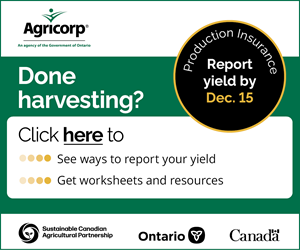Site-specific disease forecasting
USING WEB-BASED TOOLS CAN HELP MANAGE WEATHER-RELATED RISK
despite your best efforts to grow profitable, high quality, disease-free cereal crops, the biggest challenge remains the weather. While we still can’t control it, science and technology are taking us a lot closer to at least implementing best management practices to counter the negative impact weather conditions can cause.
“Diseases are driven by the disease triangle made up of pathogens, crops and environment. We can predict two sides of the disease triangle fairly accurately,” says Luc Bourgeois, Research and Development Manager with Bayer CropScience in Eastern Canada. “We know how pathogens overwinter and move around. The risk factors of various crop rotations are well understood. But environmental conditions remain the big unpredictable element.”
Fortunately, there are tools available to farmers to help make decisions on the farm. Online applications SPRAYcast, WHEATcast and DONcast were developed by Weather Innovations Inc. with support from Grain Farmers of Ontario and Bayer CropScience.
WHEATcast provides farmers advice on when to more intensely scout wheat fields for early season diseases to determine whether or not a T1 fungicide (Zadoks 12 to 39) is warranted. SPRAYcast is a tool to help producers identify periods during the day that are optimal for spraying.
DONcast, a tool designed for wheat producers, provides a means of predicting deoxynivalenol toxin (DON) concentration in wheat at harvest. The tool can help producers make informed management decisions about fungicide applications at heading, which field to harvest first and provide an advance warning of DON levels so growers can look for appropriate markets.
Weather Innovations Inc. (WIN), the developer of the modeling programs, has numerous weather stations installed across Ontario. In addition to WIN’s own weather stations, the company also draws data from other sites operated by Environment Canada and airports. Together, these sites allow for accurate site specific forecasting. “Site-specific models are a much more precise tool than the regional models previously available,” says Ian Nichols, spokesperson for WIN. “We now have weather stations installed strategically across the province that collect data every 15 minutes.”
farming by smartphone
Jeff Barlow has a weather station installed on his farm near York, Ontario and finds tremendous value in the decision making tools. He uses all three models. SPRAYcast will tell him early morning may be an ideal time to spray to avoid drift. But with the weather station, he also knows whether or not temperatures dropped overnight, causing cold temperature related stresses on his crop. If so, he’ll wait for the temperature to warm up before spraying herbicide. While herbicides themselves are unlikely to cause crop injury, applying them to already stressed plants increases the risk.
WHEATcast gives him a heads up when disease risk increases. “If WHEATcast starts telling me it’s really bad, I’ll go scout the field or have a professional scout come look,” says Barlow. “It lets me know I might need to take action. I will spray a fungicide if I have to, but I’ll try to wait until fusarium timing.” He uses DONcast in much the same way. “DONcast is pretty effective, but it’s not the bible,” says Barlow. “You still have to go look at your wheat to make the final decision.”
Barlow uses a smartphone and looks forward to the time he can receive a text message or e-mail that his wheat fields are in a high-risk situation. “The more automated the decision making can become the better.”
Barlow does have access to his weather station data from his Blackberry. “They set it up for me so I can now know right from my mobile device if there’s something wrong with the station, how the battery power is holding up, the temperature, relative humidity, soil temperature,” he says. “That’s all super helpful.”
utilizing complex information
Ultimately, the models provide farmers with complex information in a form that is easily utilized. “The models were developed in the first place to process very complex and complicated data and to make the application much more simplified but as accurate as possible to the user,” explains Dr. David Hooker, professor at the University of Guelph Ridgetown Campus and one of the developers of the models.
The three models, SPRAYcast, WHEATcast and DONcast combine both agronomic and weather information. “The models all analyze very complex agronomic data sets and they tie that with complex weather data so it helps growers make important management decisions,” continues Hooker.
Go to WeatherCentral.ca to register your fields. The services provide a wealth of information to help you manage risk and produce high quality, high value cereal crops. •






















